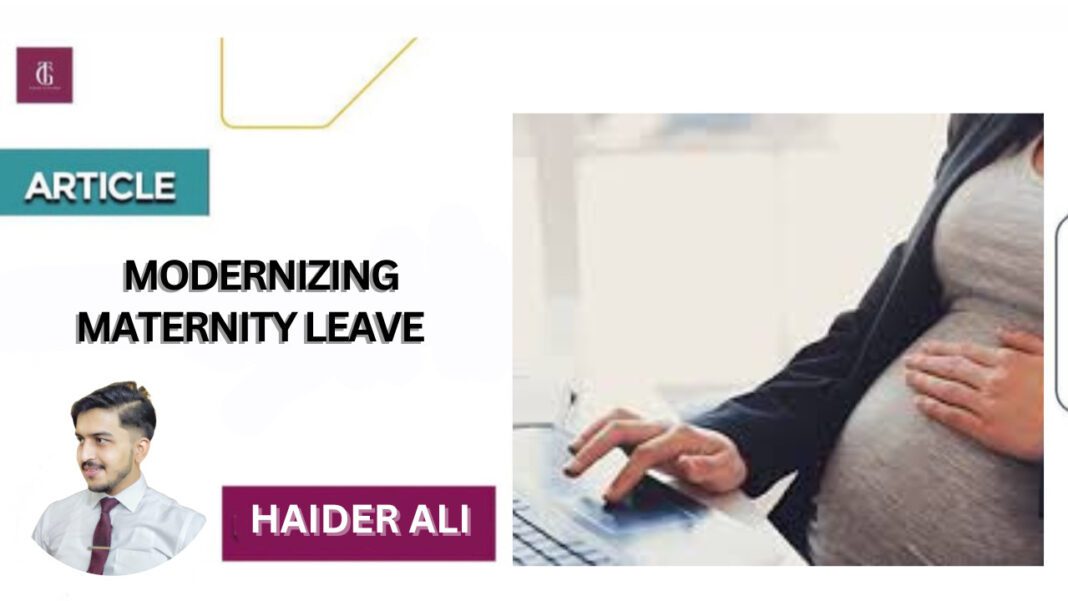In our society, working mothers are becoming more common. Many women continue their professional careers after becoming mothers out of necessity or ambition. Regardless of the motivation, a woman’s choice to fulfill both roles has repercussions for child rearing, particularly in light of our society’s gendered division of parental responsibilities.
The state is under a protected commitment, revered in Article 37 of the Constitution, to work with ladies in the exhibition of their expert obligations by giving maternity benefits. One such instrument of facilitation is the provision of maternity leave. It gives women time to prepare for and recover from the difficult task of giving birth, to care for and bond with their newborn, and to establish systems for managing their child’s care when they return to work.
In Pakistan, the legal framework for maternity leave is largely outdated and has gaps, especially in the scope of its application. The regulations for arranging maternity leave in general society and confidential areas are particular. The Government Employees Demonstration of 1973 and the Changed Punjab Leave Rules, 1981 command the arrangement of 90 days full-paid maternity pass on to female government employees (other than those utilized on an agreement or the people who qualify under the law as laborers/workers), for their initial three kids. The Punjab government also granted male civil servants a week of paternity leave for their first two children in a commendable 2012 amendment to the Leave Rules.
The Punjab Maternity Benefits Ordinance of 1958 requires “commercial and industrial establishments” to provide their female employees with 12 weeks of full-paid maternity leave, regardless of how often they take it. Women who work in mines, factories, or workshops where a manufacturing process is undertaken, in commercial agencies, joint stock companies, insurance companies, banks, hotels, and cinema houses are entitled to 12 weeks of full-paid maternity leave by the provisions of the 1958 Ordinance and the Industrial and Commercial Employment (Standing Orders) Ordinance, 1968, which defines commercial and industrial establishments.
Although the 1958 Ordinance and the 1968 Ordinance apply to various organizations, educational institutions, hospitals, and non-profit organizations may not be regulated. The meaning of business foundations, given in the 1968 Law, doesn’t completely incorporate such associations inside its ambit; however, it could be deciphered as such. This point has also been obscured by judicial precedent. Educational institutions are not considered commercial establishments by some judicial authorities. Others reserve this conclusion solely for charitable, educational establishments. Similar legal ambiguity exists regarding the applicability of the 1958 and 1968 ordinances to hospitals and their status as commercial establishments. It is unclear whether non-profit organizations not run for charitable purposes also fall outside the scope of the ordinances, even though charitable organizations appear to do so. These private institutions may impose less favorable maternity leave policies—or none—in this state of ambiguity. It is necessary to make amends for this legal ambiguity and flaw.
In today’s world, it is undeniable that fathers must (and do) play a significant role in child-rearing. Additionally, a strong support system within the family that is bolstered by the father sharing familial responsibility makes it easier for working mothers to return to the workforce. In 2012, the Punjab government made the modification mentioned above to the Leave Rules, 1981, to recognize this fact. It should be mentioned that the length of paternity leave permitted is nowhere near adequate. The law doesn’t order the arrangement of paternity leave for male workers in the confidential area, where the requirement for the organization of such help structure is the same. A bill proposing paternity leave of 90 days, relevant across areas, was presented in the Indian parliament in 2017. If the legislature approved the bill, it would set a fantastic precedent for us to follow.
The Indian parliament has started a trend regarding this matter by changing the Maternity Advantage Demonstration of 1961 to increment full-paid maternity leave from 12 to 26 weeks (a half year). A few nations, such as Australia and Sweden, have set the base term of full-paid maternity leave much higher, the north of a year. Truly, it would be hard to figure out what the perfect term of maternity leave should be. However, our state should consider and evaluate the sufficiency of the 12-week maternity leave currently permitted by our law in light of the increasing nucleation of family structures.
The state’s sacred obligation is to work with hopeful and late moms in their converging obligation to raise families and proceed with proficient commitment and improvement. The state should modernize and justify the ongoing administrative plan of maternity leave to satisfy its previously mentioned liability. This is the mandate of Articles 34 and 35 of the Constitution, which obligates the state to protect the family, mother, and child and ensure women’s full participation in all aspects of national life, in addition to Article 37.

Haider Ali
Student of politics and International Relations at Quaid e Azam university islamabad.






